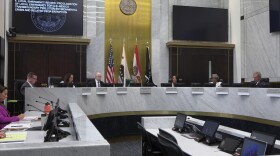Chula Vista has come under criticism over the last year for its use of new technologies, but it turns out those efforts — drones, license plate readers — were just pieces of a larger plan to become a model of policing in the 21st Century.
Long term, the city is constructing an intelligence-gathering operation with the help of a corporation that bills itself as the “eyes and ears” of emergency responders.
It will be a real-time crime center, which despite escaping the attention of the public at large, is not unique. At least 80 police departments around the country, according to one group of researchers, have built technology hubs where sworn officers and analysts can monitor what’s happening around town through displays of various video and information streams.
In December, the Chula Vista Police Department asked the City Council to waive the city’s traditional bidding process and sign a contract with Motorola Solutions “to create situational awareness” by bringing “disparate systems and data” — including camera feeds, dispatch and mapping software, jail records, drones and license plate readers — “into a single interface.” A staff report stated that one of the purposes of partnering with the company was the delivery of “more actionable intelligence” to help the city leverage its current investments in technology.
The City Council approved the request without discussion. No one from the public spoke for or against it.
The full scope of the project is not known. In an email, Capt. Phil Collum said the real-time crime center is still being developed, personnel still need to be trained and the software has yet to be configured. In addition to drone footage, the center will also have access to city-owned security and traffic cameras, he said.
But Chula Vista didn’t stop at city-owned video feeds, at least when the idea for a real-time crime center was first being kicked around. Internally, police discussed the possibility of folding footage from private doorbell cameras into the larger surveillance network, according to an email obtained through a public records request. In 2019, Voice of San Diego reported that law enforcement agencies around the region were partnering with Amazon Ring to tap into the residential and business cameras voluntarily installed by property owners and tenants to stop package thefts.
Collum said the city is no longer planning to do that.
The contract approved in December strengthens what was already a close relationship with one outside company. In 2019, Chula Vista purchased two drones “through the tremendous generosity of the Chula Vista Police Foundation,” the city stated on its website. A year later, Motorola Solutions dropped $2,000 at the Chula Vista Police Foundation’s golf tournament, the purpose of which, according to a brochure, was “to raise money to expand the drone program…”
In February, Chula Vista Police Capt. Don Redmond emailed representatives from the company to say his city was working on a Federal Aviation Administration grant that could open the door for more police departments setting up drone-as-first-responder programs.
“This would be a huge benefit for Motorola because agencies would have a funding source to start DFR,” he said.
Redmond did not respond to multiple requests for an interview. Motorola Solutions didn’t respond either.
Last year, the company announced it was launching new products allowing law enforcement agencies to expand their reach without increased spending. Instead, businesses could buy their own cameras and hand over the real-time remote viewing capability to law enforcement. San Diego tried to do just that back in 2014, pitching businesses to give police access to private security cameras to create a real-time network dubbed “Operation Secure San Diego.”
The police claim it helps in many ways. At a presentation last year, Redmond showed drone footage of a man waving an object that someone who called 911 had identified as a firearm. The drone pilot determined the object was actually a lighter. Redmond said the drone was instrumental in de-escalating a potentially deadly situation with officers.
But the linking up of disparate sources of data and pieces of technology across the country is alarming privacy advocates. The drones and other tools making their way to local law enforcement were in large part developed for the military and used in U.S. counterinsurgency efforts abroad. That those same devices are being turned inward is causing anxiety that seems to confound officials.
Privacy and criminal justice advocates have been warning for years that real-time crime centers are pushing police into unprecedented territory by stockpiling data points about people, many of whom haven’t been accused of wrongdoing. In turn, there’s a risk that the information won’t just be used against individual members of the public but against other members of the government, including cops.
“You can learn a lot of details about someone’s life without being under investigation, and that’s very troubling,” said Freddy Martinez, a policy analyst at the transparency group Open The Government. “The potential for abuse is just so high.”
The security of sensitive data is also a concern. A couple years ago, hackers breached the company that makes license plate readers for the U.S. Government and posted the information on the dark web.
Real-time crime centers, by taking technology tested overseas and deploying it domestically, represent a less obvious example of militarizing local police departments. It’s harder to spot because “you always think the militarization of police is just riot shields and tanks,” Martinez said.
Critics also contend that real-time crime centers create not only a dependency between a city and a profit-seeking entity, but incentives for new purchases.
“Once you create this system, you must use it more to justify the expense,” said Albert Fox Cahn, executive director of the Surveillance Oversight Technology Project in New York City. “When you’re creating something and its main value is the ability to plug in all these different data sources, well, now every vendor can come in and say, ‘Look at the millions you’ve spent. It’s only gonna be a couple more thousand to plug my particular system into that, and once you do, you can cross-reference it with every other tool.’”
The reason technology companies are looking for partners at the local level is because they’ve run out of customers in the federal government, Fox Cahn said, but the products they sell remain ineffective, anti-democratic, biased, invasive and subject to change. In New York City, he said, the technology that officials purchased for counterterrorism has been repurposed to track the city’s unhoused population.
“It’s not this slow progress anymore,” he said. “We see surveillance being used in ways that would have been utterly inconceivable years ago.”
The City Responds
Three days after the City Council approved the Motorola Solutions contract, the Union-Tribune published a story about the city’s use of license plate readers, which photograph and log the location, date and time of vehicles that pass by. Although elected officials signed off on the initial purchase of the technology, the specifics of the program — and the fact the city had elected to share data with immigration authorities — weren’t commonly known.
As criticism over that decision grew, officials announced that they would suspend their data-sharing with immigration authorities, invite the California Department of Justice for an audit and hold a forum with the public. It was a long-awaited chance for community members to ask the city about license plate readers, but officials declined to answer any questions. One week later, the Chula Vista City Council approved its license plate reader program for another year but asked the city’s Human Relations Commission to review the program on a quarterly basis.
To justify the license plate reader program, police leaders and the City Council argued that violent crime is up and the police roster is down.
“Technology has the ability to be invasive, but it also is a tool, and it’s a necessary tool, and especially a necessary tool when we know that our city is growing, that we have a lot of strain in our community,” said Mayor Mary Casillas Salas.
Police Chief Roxana Kennedy also made the case that drones and license plate readers are not a form of surveillance, and not the problem.
“You can’t walk outside and not be in a public forum … I think the biggest violator of our privacy right now is this,” she said, holding up her cell phone. “This knows everything about me. And I agreed to accept Facebook and now it tells me everything about myself before I even ask for it.”
The difference, of course, is that people choose to open a social media account.
At the same time, officials argued that the technology they’ve acquired doesn’t capture personal information and doesn’t violate the constitutional protection against unlawful search and seizure.
But as the Electronic Frontier Foundation noted earlier this year, license plate data reveals quite a bit about people’s travel habits and daily routines, accessible with only a few keystrokes. The digital rights group found that nearly all license plate data collected by California law enforcement is unrelated to a crime.
Between 2018 and 2019, Chula Vista got a hit on a vehicle of interest 0.03 percent of the time. Newer data that the city released online show that the hit rate between April and June 2021 was 0.025 percent.
Pedro Rios, a human rights advocate with the American Friends Service Committee, has argued that Chula Vista’s technological ambitions are undermining its own designation as a welcoming community for immigrants. In an interview, he said the city’s close relationship with private surveillance producers — two former cops now work for drone companies that do business with the city and other governments — raises ethical questions.
The problem, as Rios sees it, is that Chula Vista has prioritized its image as a leader in technology before securing buy-in from the people who will be impacted.
“I would expect a city as large as Chula Vista, that bills itself as innovative, would want to include perspectives and consult with city residents, but I don’t see that happening with these city officials unless they’re pushed to do so,” he said.
Rios is part of a group of community members who are advocating that the City Council consider stronger rules around the acquisition and use of surveillance devices, similar to what San Diego is proposing, which is itself based on ordinances in Oakland and elsewhere, as well as a citizen advisory board.
In response, the city’s chief innovation officer confirmed he was working on a citywide privacy policy. That proposal is expected to come up for public review and discussion in the fall.
In the meantime, Councilman Steve Padilla said he’s working on another proposal to create a new commission of experts in emerging technology and other areas who can independently review the city’s use of technology to make sure it’s transparent and respects laws around personal privacy. The purpose of which, he said, is to provide “feedback to the mayor and Council that says, ‘You’re complying or not, and here are the trouble spots.’”
But Padilla also pushed back against the criticisms of real-time crime centers in general, arguing that they are a legitimate tool to bring the existing infrastructure of the city together to assist in emergency responses. He said he takes apocalyptic portrayals with a grain of salt.
“It’s not a network that is up and running and spying on people,” he said. “It is there to provide data in real time, and in the long term come up with analytics to prevent crime and enhance public safety.”








